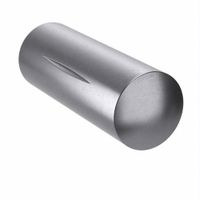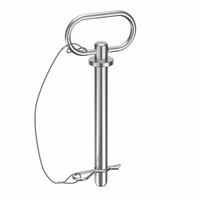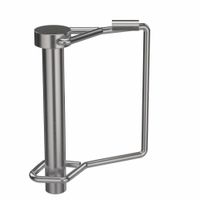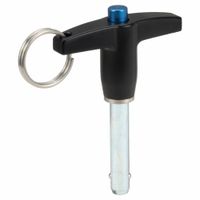Call +(254) 703 030 000 / 751 483 999 / 721 704 777
.....Read More
Frequently Asked Questions
What are the differences between dowel pins and clevis pins?
Dowel pins and clevis pins are both types of fasteners, but they serve different purposes due to their distinct designs.
Dowel pins are solid cylindrical fasteners used to align components in machinery or to provide a precise pivot point. They are typically unthreaded and rely on a snug fit within corresponding holes to create a secure, fixed joint. Dowel pins are often used in applications where precise alignment and shear strength are crucial, such as in jigs, fixtures, or to prevent rotational movement between parts.
Clevis pins, on the other hand, are designed for applications requiring a movable pivot or connection. They feature a head on one end, a solid shaft, and a hole drilled through the other end, allowing a cotter pin, split pin, or R-clip to be inserted to secure the pin in place. Clevis pins are commonly used to connect two or more parts that need to articulate or pivot relative to each other, such as in hitch attachments, control linkages, or the ends of hydraulic cylinders. They are ideal for applications where quick assembly and disassembly are required, and where axial retention is provided by the securing element.
In summary, dowel pins are for precise, static alignment and shear strength, while clevis pins are for dynamic, pivoting connections that require easy assembly and disassembly.
How do cotter pins secure components in place?
Cotter pins are simple, yet effective fasteners used to secure components by preventing axial movement or rotation. They typically consist of a two-pronged metal pin with a head at one end. To use a cotter pin, it is inserted through a pre-drilled hole in a shaft, bolt, or clevis pin. Once inserted, the two prongs are bent outwards, usually in opposing directions, creating a secure lock. This bending action prevents the pin from being pulled out of the hole, thereby holding the attached components firmly in place. They are commonly used in applications where quick assembly and disassembly are required, or where vibration might cause other fasteners to loosen. Examples include securing castle nuts on axles, holding wheels on carts, or attaching linkages in machinery.
What are the applications of industrial safety pins?
Industrial safety pins, while seemingly simple, have a wide range of applications across various industries due to their robust design and secure fastening mechanism. They are commonly used in manufacturing for temporary fastening of components during assembly processes, holding fabric layers together in textile production, or securing tags and labels to products for identification.
In the packaging sector, these pins are invaluable for sealing bags, attaching handles to boxes, or securing protective coverings. Their durability makes them suitable for use in demanding environments, such as construction sites where they can be used for securing tarpaulins or temporarily holding materials.
Beyond industrial settings, safety pins find utility in a surprising number of fields. In the arts and crafts world, they are used for creating intricate designs, securing embellishments, or even as functional elements in clothing and accessories. In emergency or field repair situations, they can serve as makeshift fasteners for torn fabric, broken straps, or to secure equipment. Their versatility, combined with their simple yet effective design, ensures their continued relevance in numerous applications where a reliable and temporary fastening solution is required.
How do grooved pins create a friction fit?
Grooved pins create a friction fit through the displacement of material when inserted into a hole. The grooves along the pin's body are slightly larger in diameter than the hole into which they are pressed. When the pin is inserted, the material of the pin within the grooves is compressed. This compression creates radial forces against the walls of the hole, resulting in a secure, interference fit. The displaced material of the pin within the grooves acts like a spring, maintaining constant pressure and preventing the pin from loosening due to vibration or shock. This design eliminates the need for threads or other fasteners, making grooved pins a simple, cost-effective, and reliable solution for many applications.
What is the purpose of hitch pins in securing trailers?
Hitch pins are crucial for securing trailers to towing vehicles. Their primary purpose is to prevent the trailer coupler from detaching from the hitch ball or receiver. They act as a simple yet effective locking mechanism, typically by passing through a hole in the hitch receiver and coupler assembly, or through the latching mechanism on the coupler itself. This ensures that even with bumps, turns, or sudden movements, the trailer remains firmly connected. Without a properly inserted hitch pin, the trailer could easily separate from the tow vehicle, leading to dangerous situations on the road. They are an essential safety component for anyone towing a trailer.
How do spring pins maintain their position in assemblies?
Spring pins, also known as roll pins or coiled pins, maintain their position in assemblies primarily through a combination of friction and the inherent spring action of their design. When a spring pin is inserted into a drilled hole, its outer diameter is intentionally larger than the hole's diameter. This oversize condition causes the pin to compress inward, generating radial forces that exert pressure against the hole walls. This radial pressure creates a strong frictional grip between the pin and the host material.
Additionally, the elasticity of the spring pin material allows it to deform and then spring back, continuously pressing against the hole. This spring action provides a consistent and reliable retention force, making the pin resistant to loosening from vibrations or shock. The slot or coil in the pin's design also contributes to its flexibility and the even distribution of radial force within the assembly. This combination of friction and constant outward pressure ensures the pin remains securely seated, providing a reliable and robust connection.
What are the advantages of using lynch pins?
Lynch pins are simple, reusable fasteners designed for quick attachment and detachment. Their primary advantages include ease of use, as they can be inserted and removed without tools, and security, due to their self-locking mechanism that prevents accidental disengagement. They are highly versatile and commonly used in agricultural, automotive, and industrial applications for securing shafts, clevis pins, and other components, providing a reliable and cost-effective fastening solution.
How do taper pins increase their holding power?
Taper pins increase their holding power primarily through a wedging action. When a taper pin is inserted into a tapered hole, the slight difference in diameter along its length causes it to exert radial pressure against the walls of the hole as it is driven in. This creates a strong frictional force that resists axial movement and rotational forces.
The key to their effectiveness lies in the precise taper (typically 1:48 or 1:50, meaning for every 48 or 50 units of length, the diameter changes by 1 unit). This small angle allows for a gradual increase in interference fit as the pin is seated, leading to a high degree of holding power without excessive stress on the surrounding material.
Additionally, the smooth surface finish of taper pins and the corresponding smooth hole contribute to the intimate contact necessary for this wedging effect. This design makes them highly effective for precisely aligning components, securing assemblies, and transmitting moderate torques, especially in applications where disassembly might be required.
What are quick-release pins used for?
Quick-release pins are versatile fasteners used to quickly and securely connect or disconnect components without the need for tools. They typically feature a spring-loaded ball or a locking mechanism that can be easily retracted to allow the pin to be inserted or removed from a hole.
Their primary advantage lies in their efficiency and ease of use, making them ideal for applications requiring frequent assembly and disassembly. Common uses include: * **Aerospace:** Securing access panels, engine components, and landing gear.
* **Manufacturing:** Fastening jigs, fixtures, and tooling.
* **Marine:** Attaching bimini tops, boat covers, and deck hardware.
* **Automotive:** Holding down hoods, trunks, or temporary body panels in racing.
* **Photography/Videography:** Mounting cameras, lights, and accessories to tripods and rigs.
* **Sports Equipment:** Adjusting and securing parts on bicycles, exercise equipment, and tents.
* **Medical Equipment:** Assembling and disassembling hospital beds, wheelchairs, and diagnostic devices.They come in various styles, including detent pins, ball lock pins, and positive locking pins, each designed for specific load requirements and environments. The choice of material (e.g., stainless steel, aluminum) also depends on factors like corrosion resistance and strength.
How do you choose the right type of pin for an assembly?
Choosing the right type of pin for an assembly is crucial for its functionality, durability, and cost-effectiveness. Several factors should be considered.
Firstly, the application's specific requirements are paramount. What is the pin's purpose? Is it for alignment, fastening, pivoting, or something else? This will dictate the necessary strength, precision, and material properties. For instance, a pivot pin will require excellent wear resistance, while a shear pin needs to fail under specific load conditions.
Secondly, consider the load and stresses the pin will endure. This includes shear, tensile, bending, and torsional forces. The pin material must be strong enough to withstand these loads without deforming or breaking. Factors like static versus dynamic loads, shock loads, and vibration also play a role. Common materials include various grades of steel (e.g., carbon steel, stainless steel for corrosion resistance), brass, aluminum, and even plastics for lighter loads or specific electrical properties.
Thirdly, the environment in which the assembly operates is critical. Will the pin be exposed to moisture, chemicals, extreme temperatures, or corrosive elements? This will influence the choice of material and any necessary coatings or surface treatments. For example, stainless steel or protective coatings are essential in corrosive environments.
Fourthly, manufacturing and assembly considerations are important. What are the tolerances required for the pin and its mating holes? Precision pins ensure accurate alignment, while loose-fitting pins might be acceptable for less critical applications. The ease of insertion and removal, as well as the assembly method (e.g., press-fit, reamed fit), should also be taken into account.
Finally, cost and availability are practical considerations. While performance is key, balancing it with the budget and the availability of standard versus custom pins is important. Standardized pins are generally more cost-effective and readily available.










